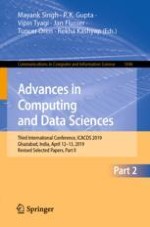2019 | Book
Advances in Computing and Data Sciences
Third International Conference, ICACDS 2019, Ghaziabad, India, April 12–13, 2019, Revised Selected Papers, Part II
Editors: Mayank Singh, P.K. Gupta, Prof. Vipin Tyagi, Prof. Jan Flusser, Tuncer Ören, Rekha Kashyap
Publisher: Springer Singapore
Book Series : Communications in Computer and Information Science
